
 |
JPL's Wireless Communication Reference WebsiteChapter: Cellular Telephone Networks. |
To ensure that the mutual interference between users remains below a harmful level, adjacent cells use different frequencies. In fact, a set of C different frequencies {f1, ..., fC} are used for each cluster of C adjacent cells. Cluster patterns and the corresponding frequencies are re-used in a regular pattern over the entire service area.
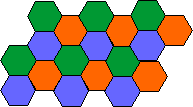 Frequency reuse plan for C = 3, with hexagonal cells. (i=1, j =1)
|
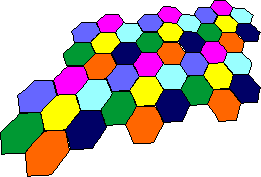 Frequency reuse plan for C = 7 (i=2, j =1). |
The total bandwidth for the system is C times the bandwidth occupied by a single cell.
| In the practice of cell planning, cells are not hexagonal as in the theoretical studies. Computer methods are being used for optimised planning of base station location and cell frequencies. Pathloss and link budgets are computed from the terrain features and antenna data. This determines to coverage of each base station and interference to other cells. |
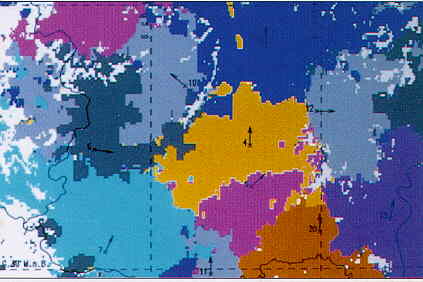 Source: Siemens TORNADO D Cellular Planning Tool |
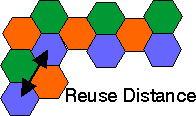 The closest distance between the centres of two cells using the same frequency (in different clusters) is determined by the choice of the cluster size C and the lay-out of the cell cluster.
This distance is called the frequency 're-use' distance. It can be shown that the reuse distance ru, normalised to the size of each hexagon, is
The closest distance between the centres of two cells using the same frequency (in different clusters) is determined by the choice of the cluster size C and the lay-out of the cell cluster.
This distance is called the frequency 're-use' distance. It can be shown that the reuse distance ru, normalised to the size of each hexagon, is ru = SQRT{3 C}
For hexagonal cells, i.e., with 'honeycomb' cell lay-outs commonly used in mobile radio, possible cluster sizes are C = i2 + ij + j2, with integer i and j (C = 1, 3, 4, 7, 9, ...). Integers i and j determine the relative location of co-channel cells.
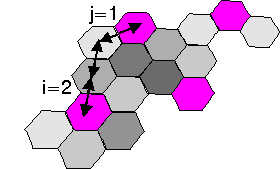
7-cell reuse with i = 2 and j =1.
 Derivation
DerivationListen to an animated audio presentation by Jean-Paul Linnartz (embedded html, SMIL, PPT-only)
Also, for more details on the math behind hexagonal cell layouts, check this pdf document.
In practical FM or digital cellular networks for public radio telephony, the cluster size mostly is on the order of C = 7 or 9, though with special techniques, such as diversity reception, smaller re-use distances can be used. GSM can work with C = 3 or 4.
Cellular CDMA systems can use C = 1, i.e., the same frequency is used in all cells.
Here, Ac is mostly computed from Erlang B formulas, with Ac equals the attempted traffic multiplied by the probability of success (= 1 - blocking probability).Ac SE = ----------- BT C M Su
Mostly, the spectrum efficiency is expressed in erlang/MHz/km2.
Thus, we observe that the spectrum efficiency decreases with the cluster size C. System performance, for instance expressed in terms of the outage probability or the bit error rate experienced by the user, improves with increasing re-use distance, so it improves with the cluster size. Hence, achieving high system performance and efficient use of the radio spectrum are conflicting objectives for a network designer.
 Erlang B Calculator
Erlang B CalculatorDisclaimer: Executable software programmes are provided with no guarantee whatsoever. See License.
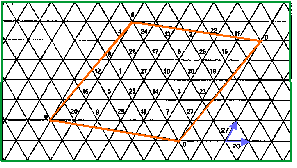
Figure: Typical 31- frequency reuse pattern for FM radio (CCIR).